The Acer Swift 3 SF314 Notebook Review: Swift Gets Swifter With Ryzen 4000
by Brett Howse & Andrei Frumusanu on May 5, 2020 8:00 AM ESTSystem Performance
AMD’s new Renoir platform has already been showcased in our SPEC testing, which made a clear case that the new design provides a much-needed performance bump over the previous Picasso platform. Despite the individual cores having generally lower single-threaded performance than Intel’s Ice Lake, they make up for that deficiency with sheer volume, doubling the core count of the competition. AMD’s mantra for the entire Zen existence has been more for less, and that continues here again. Acer has positioned this laptop at an entry-level price, but with performance that should meet or exceed other devices in its class.
Both AMD based models of this 14-inch Acer Swift 3 come with 8 GB of RAM, in the DDR4-3200 flavor, which is where notebooks need to be these days for an entry position, so it was nice to see them offer 8 GB on both the Ryzen 5 and Ryzen 7 models. The company could have cut back to hit an even lower price point, especially on the Ryzen 5, but that would impact the performance too much to make it a worthwhile compromise. They’ve also started with a 256 GB SSD on the Ryzen 5 model, and bumped that up to 512 GB on the Ryzen 7 we have here, and still at just $649, which is fantastic value and should keep the target market happy for some time.
To see how the Acer Swift 3 with Ryzen 7 4700U performs, we have run it through our laptop test suite and compared it to several other similar systems. If you'd like to compare the Acer Swift 3 to any other laptop we have tested, please check out our online Bench.
PCMark
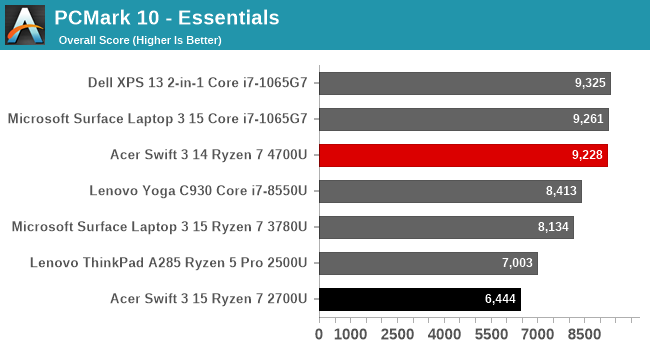
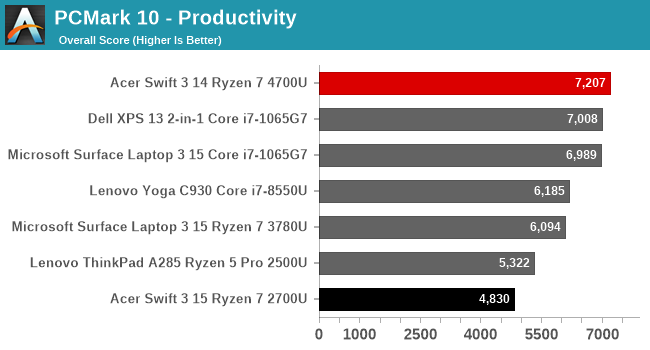
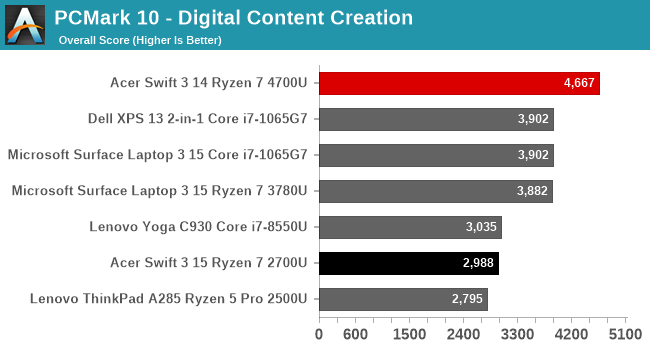
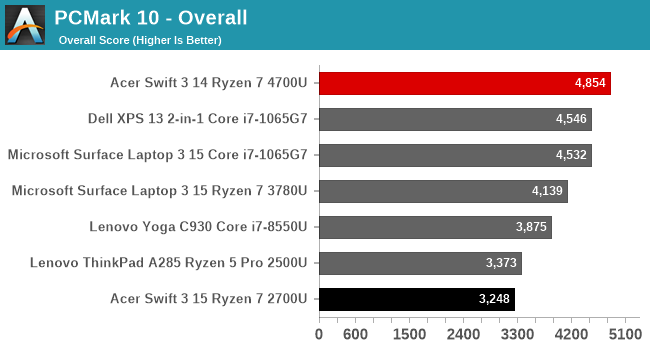
UL’s PCMark suite offers some real-world test cases, and tests all aspects of the system, from CPU performance, to GPU, to even app-loading times and disk performance. The Acer Swift 3 performs very well here, especially in the digital content creation sub-tests, where the GPU gets to showcase some of its prowess.
Cinebench R20
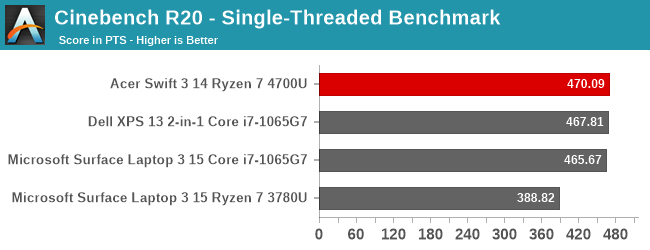
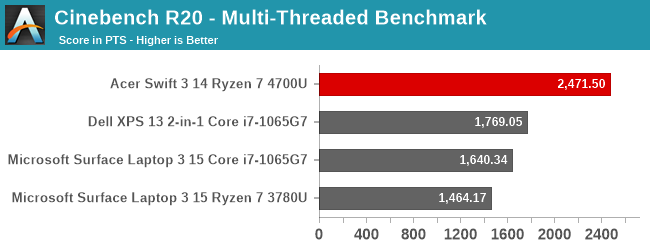
AMD has been touting its Cinebench results for some time since their launch of Zen, and for good reason. As a compute-focused test, the Zen 2 cores perform very well here, and having eight physical cores in the multithreaded results really make the Ryzen 7 4700U stand out. SMT has been a great way to get more performance per-core, but there is still no substitute for actual cores.
x264

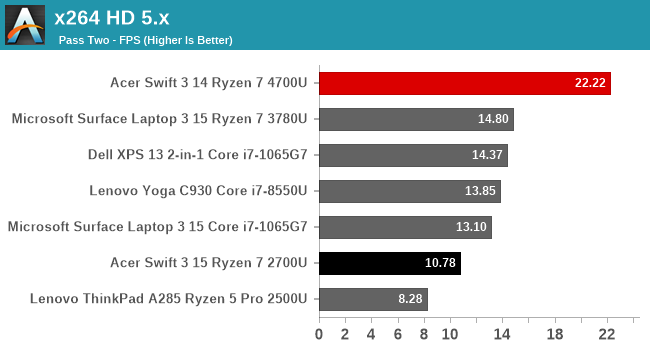
The x264 test transcodes a video using the CPU and has always enjoyed more CPU performance and more CPU cores, so it should not surprise anyone that the Ryzen 7 4700U wins the day here again. Eight cores make short work of this transcode.
Handbrake
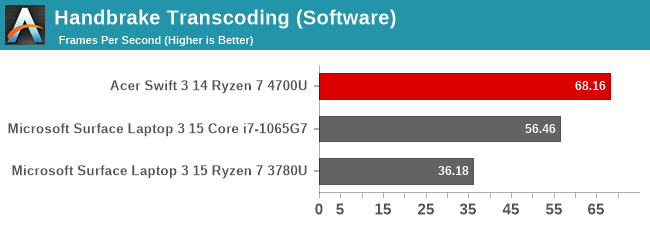

Handbrake is arguably the most popular video transcode tool around, and it offers both software-based CPU transcoding, as well as GPU accelerated. On our last Picasso platform, the Microsoft Surface Laptop 3, Handbrake wasn’t able to leverage Vega’s Video Core Next hardware, however the Acer Swift 3 can, and in both software and hardware encoding, the Renoir based Acer Swift 3 finishes this task very quickly.
7-Zip
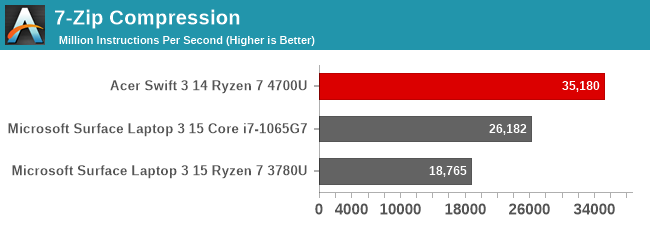
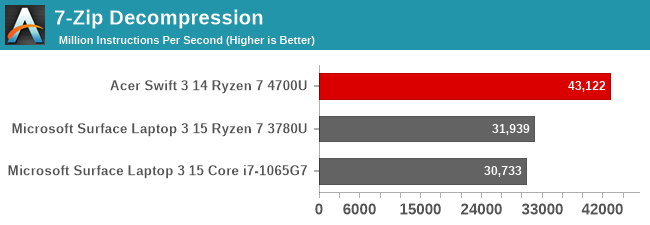
7-Zip is a very popular, free file compression and extraction tool, and it also offers a built-in benchmark. AMD’s Renoir SoC once again outperforms the rest of the 15-Watt systems here. Tests such as this and transcode do very well with the extra cores provided on the Ryzen 7 4700U.
Web Benchmarks
This will likely be our last review with the older web tests. Web benchmarks are as much about the browser’s scripting engine as they are about pure CPU performance, so for consistency we’ve tested in Microsoft Edge. Now that Edge is being moved to the new Chromium-based version, we’ll take this opportunity to replace some of our older tests.
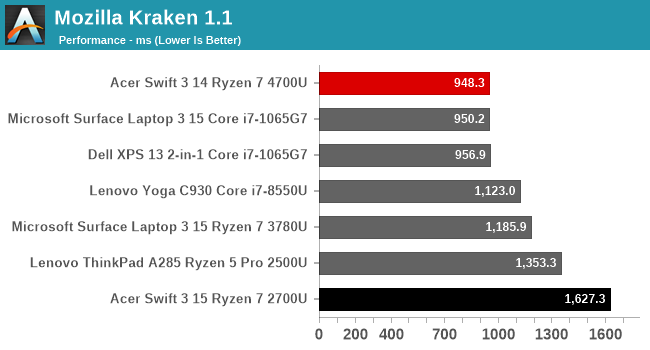
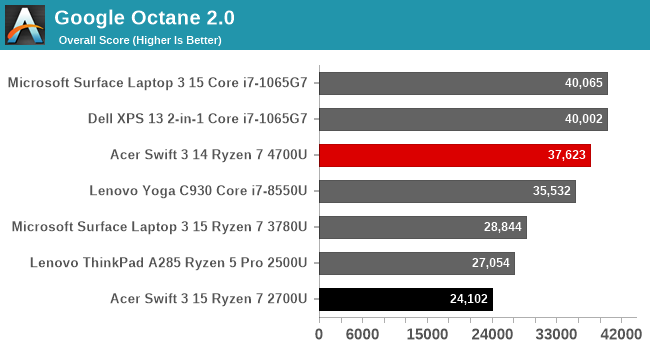
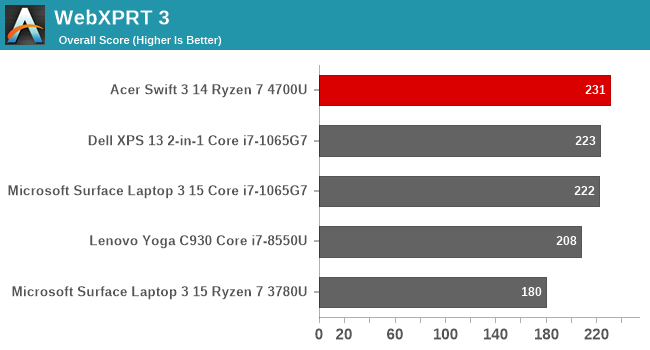
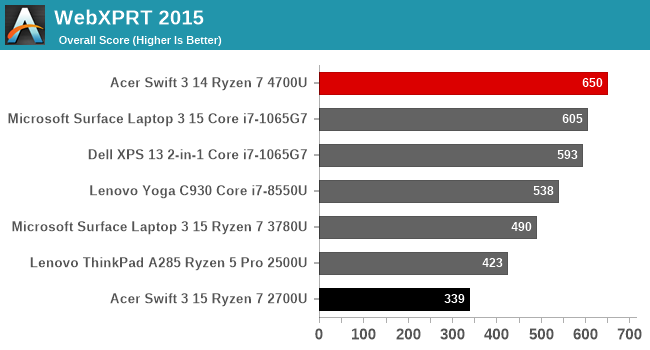
Web tests also tend to be more sensitive to the CPU being able to ramp up its frequency quickly, and that is an area where AMD’s systems did not perform quite as well. Luckily for Renoir, those issues are behind AMD, and the Acer Swift 3 performs very well.
Storage
One of the best things about the Acer Swift 3 is how much storage it comes with considering its price point. The review unit offers 512 GB of SSD storage, and although you may expect slower, cheaper SATA storage here, that is not the case. The Acer Swift 3 ships with NVMe PCIe 3.0 x4 storage, and in the case of the review unit, that means a Samsung PM991 SSD inside.
Performance is excellent. Despite this being a budget notebook, the storage options are very welcome. A base model offering 256 GB is a great start, but a proper NVMe SSD as well makes this laptop even more value.
System Performance Conclusion
Although AMD has really made inroads in the desktop space since the launch of Zen, in the laptop space where power is at a premium, what made the early Zen based APUs stand out was not the CPU but the GPU. Since then, Intel released Ice Lake, offering similar GPU performance but with much higher CPU performance. Now that AMD is on their third-generation of Zen-based laptop APUs, that performance lead has all but evaporated. In our SPEC results, Intel still has the single-threaded lead, but AMD more than makes up for that by offering eight CPU cores, compared to just four on Ice Lake. The Ryzen 7 4700U that Acer has fitted into this Swift 3 is likely to be one of the more popular options, and for good reason. Despite it not offering SMT, the performance is fantastic.


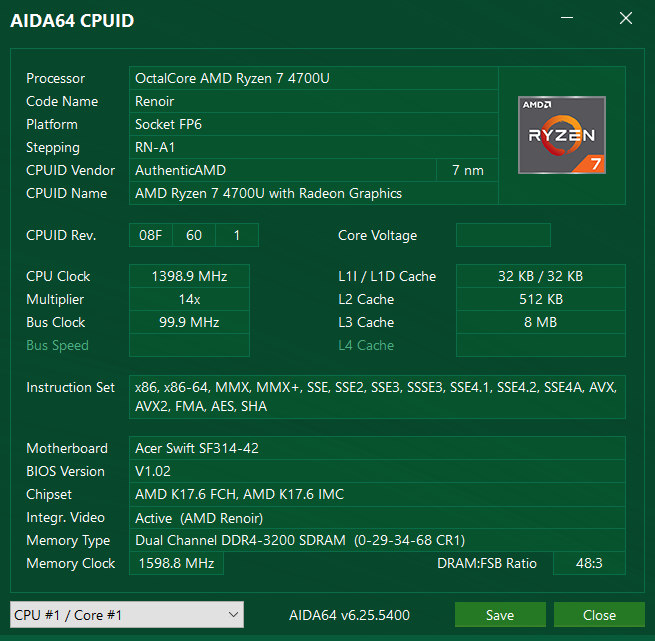









191 Comments
View All Comments
Roland00Address - Monday, May 11, 2020 - link
MSRP prices are never rational, especially on commodities who often sell much less than their MSRP. While "branded / halo" items rarely deviate from their MSRPs.yeeeeman - Tuesday, May 5, 2020 - link
"and allows them to compete not just on performance, but battery life as well" - how it allows them to compete when we clearly see in the normalized test that they are 25% worse compared to Intel?yeeeeman - Tuesday, May 5, 2020 - link
Nevertheless, the implementation is disappointing since it cannot sustain a stable frequency, so gaming will be hard on this...I guess that 650$ price is not without of reason...Steve1992 - Tuesday, May 5, 2020 - link
The frequencies are fine: https://youtu.be/Xyns9jjEt5MSteve1992 - Tuesday, May 5, 2020 - link
Better example: https://youtu.be/pGgY-Aw2dZoneblogai - Tuesday, May 5, 2020 - link
They are OK, but could be better. iGPU can keep the frequences in CPU-light games, but drops them in CPU heavy games like Forza Horizon, Dota2, and especially Battlefield V multiplayer. Also, in case of GTA5 benchmark you posted- note that the video starts with APU at 25W, which is while APU is still boosting (several minutes). Then it goes to sustained power limit of 18W, and will stay there, with lower power and clocks.Flunk - Tuesday, May 5, 2020 - link
Low priced thin and lights with integrated graphics are all pretty much useless for gaming. It's not a reasonable or use case... at least according to notebook designers.DanNeely - Tuesday, May 5, 2020 - link
Gaming on a laptop with an IGP will never be a great experience because you either have to turn the quality settings down a lot or play older/less graphically complex titles; but that doesn't mean people don't do it. There's no easy way to get a desktop/mobile split, but ~10% of systems in the Steam HW Survey use some Intel GPU; I suspect a majority of them are laptops because it's where you're stuck with the IGP and can't slap in even a cheap discrete GPU for faster speeds.The GPU here isn't a 200W discrete card, or even a 40W discrete card; but it is a step above Intel's IGPs. That makes it an attractive option for someone who wants to be able to game on a laptop without spending a lot more and sacrificing profitability.
I do it some of the time when away from home on an old XPS13 with a i7-6xxx. It's a limited experience, especially after this many years, but is still better than mobile gaming on my phone.
philehidiot - Tuesday, May 5, 2020 - link
It has always been the case that if you want a decent gaming laptop, you're paying big bucks. I think the pricing here is pretty damned awesome. I'd never buy a laptop like this for gaming. It's that simple. The Vega GPU is kinda nice to have but integrated graphics are simply not meant for decent gaming. It's that simple. If you're looking at this and thinking "ooh gaming machine", you need to recalibrate your expectations.neblogai - Tuesday, May 5, 2020 - link
Well, gaming does not have to be the latest AAA specifically. Majority of best games will run on this integrated Vega very well. Most E-sports are also playble. And even a lot of best latest AAA will run well enough to experience and enjoy the game (if the game has to offer more than just graphics).